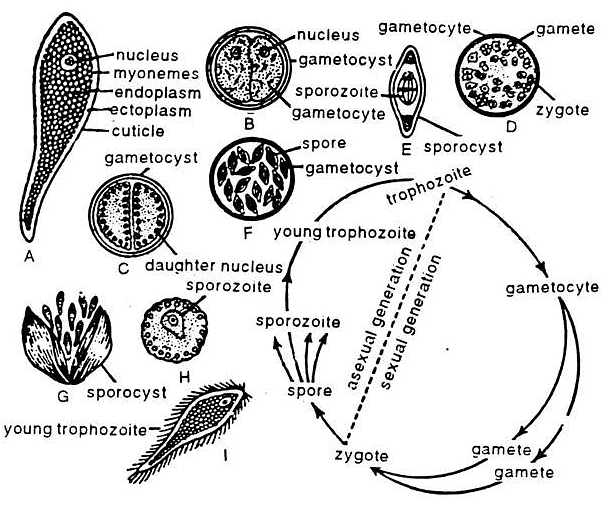UPSC Exam > UPSC Notes > Zoology Optional Notes for UPSC > Life History of Monocystis
Life History of Monocystis | Zoology Optional Notes for UPSC PDF Download
Monocystis Structure Overview
Trophozoite Characteristics- Shape: The body is spindle-shaped, flattened, and enveloped in a delicate cuticle layer. The front end is wider, while the back end tapers off.
- Cytoplasm Composition:
- Ectoplasm: A thin external layer.
- Endoplasm: An inner, grainy substance.
- Myonemes: These resemble the muscle fibers found in more complex organisms, situated in the cortex's innermost layer.
- Nucleus: Positioned near the anterior end, this large nucleus features a prominent nucleolus and a distinct nuclear envelope.
- Mobility: Exhibits slow movements through body contractions and relaxations.
Life Cycle of Monocystis
Sexual Reproduction Process
- Initial Contact and Cyst Formation
- Two trophozoites come together and round off, secreting a double-walled cyst around themselves. This stage is called gametocyte, and the individuals within are termed gametocytes.
- Nuclear Division and Gamete Formation
- The nucleus in each gametocyte divides multiple times, including a phase of pragametic meiosis, producing numerous daughter nuclei.
- These nuclei position themselves at the periphery, leading to the cytoplasm enclosing each nucleus to form many gametes.
- Gamete Liberation
- As gametes start to move, the dividing wall between gametocytes dissolves, releasing gametes within the shared cyst.
- Fertilization and Zygote Formation
- Gametes from both gametocytes pair up and fuse to form zygotes.
- Sporocyst Development
- Each zygote encases itself in a boat-shaped chitinoid shell, becoming a spore, and the shell is referred to as a sporocyst. Collectively, this structure is called pseudonavicella.
- Sporozoite Generation
- The spore’s nucleus divides three times, resulting in 8 nuclei. Cytoplasm gathers around these nuclei, forming 8 sickle-shaped sporozoites packed inside the sporocyst.
- These sporozoites require transfer to a new Pheretima (earthworm) to proceed with further development.

Overview of Parasite Transmission
Transmission refers to the process by which parasites move from one host to another.
Methods of Sporocyst Transmission
- Through Soil Contamination
- Decomposition: When an infested earthworm dies, its body decomposes, releasing sporocysts into the soil. These can then enter another Pheretima via soil ingestion.
- Predation and Excretion
- Birds may consume infested Pheretima. The digested matter, excluding the undigested sporocysts, is excreted and mixes with the soil, which may then be ingested by another earthworm.
- During Mating
- Some seminal fluid from earthworms, containing sporocysts, may contact the soil during mating. These sporocysts mix with the soil and can be ingested by other earthworms.
Adaptation in the New Host
- Sporozoite Liberation
- Upon entering the Pheretima's intestine, the sporocyst is dissolved by specific enzymes, freeing the sporozoites.
- Intracellular Parasitism Initiation
- The sporozoites penetrate the intestinal wall, migrate to the coelom, and move to the ciliated funnels of the male reproductive system, living temporarily as intracellular parasites.
- Attack on Sperm Morulae
- Exiting the funnels, sporozoites infect sperm morulae cells, continuing as intracellular parasites.
- Development to Trophozoites
- The young trophozoites leave the sperm morulae, reaching the vesicula seminalis where they absorb seminal fluid and mature into adults.
Impact of Parasitism
- On the Host (Pheretima)
- Although Monocystis destroys numerous sperm cells, the production of spermatozoa typically exceeds what is needed, resulting in minimal harm to the host.
- On the Parasite (Monocystis)
- The parasite experiences extensive degeneration of vegetative organelles due to the readily available food, affecting organs of locomotion, digestion, etc.
- Despite the high risk of destruction during transmission, the production of numerous spores ensures the continuation of the species, as some spores successfully infect new hosts.
The document Life History of Monocystis | Zoology Optional Notes for UPSC is a part of the UPSC Course Zoology Optional Notes for UPSC.
All you need of UPSC at this link: UPSC
|
181 videos|346 docs
|
Related Searches

















